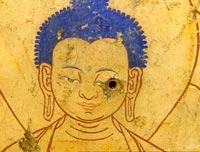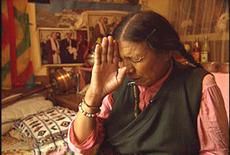Tibet: Cry of the Snow Lion


"Free Tibet" is the rallying cry for actors like Richard Gere, Tim Robbins, and Susan Sarandon, and rock groups like the Beastie Boys, REM, and the Foo Fighters. But beyond that, not many people know a lot about why Tibet is such a cause celebre. They know that the Dalai Lama is in exile, won a Nobel Prize a few years ago, and travels the world, but that's about all. Tibet: Cry of the Snow Lion is an excellent primer on the history of Tibet and its current struggles for independence. Make no mistake about it, Cry of the Snow Lion is not an unbiased documentary. It clearly advocates the cause for a Tibet free from China, but it is so well researched, passionate about its cause, and reasonable in its assumptions that it's hard not to be persuaded by its arguments.
In addition to the history of Tibet, there is a brief history on Buddhism, which is a huge influence on the manner in which Tibetans think and act. Director Tom Peosay (who made multiple journeys to Tibet to film footage under great danger to himself) quickly shows how ancient Tibetans went from a war-like culture to one of contemplation and the study of philosophy. They cultivated their minds, and became renowned throughout Asia for their learnings. More importantly, China used some of its military forces to protect non-violent Tibet. Because of this, China invaded Tibet in 1949, and "liberated" the Tibetans. From this point on, China treated Tibet like a rogue province, although, as many Tibetans posit, they do not look Chinese, and they speak a separate language. Communists harshly cracked down upon Buddhist monks and nuns, equating religion to a dangerous activity.
The Chinese government is conquering Tibet by sheer numbers. They provide incentives for Chinese to move there en masse, and treat native Tibetans like a lower class. Tibet, often called "the roof of the world" is so important because of its location. Strategically, the country that controls Tibet controls all of Asia. It sits right in between two nuclear powers that happen to be the most populous nations in the country (with about half of the world's population). China captured and cruelly tortured Tibetans, while destroying centuries old monasteries. Peosay and writers Victoria Mudd (Broken Rainbow) and Sue Peosay give heartbreaking firsthand accounts of torture by monks and nuns.
There are two reasons why the cause of Tibet is so easy to fall behind. First, is the Dalai Lama. He is extremely smart and well-spoken, and presents a convincing cause for his country. He espouses non-violent means to achieve his goals, and the actions of his followers show that the will obey him. In light of what former UN Ambassador Jeanne Kirkpatrick labels "genocide" by the Chinese, the Dalai Lama and other Tibetans entreaties seem all the more powerful. The second reason is the opposite. Chinese officials (which Peosay makes sure to interview) often give vague, wooden, political responses to questions about Tibetan freedom.
So what does the future hold? As China begins to industrialize, Tibet faces an even greater crisis. The CIA used to fund and train Tibetan freedom fighters, but this changed as Kissinger and Nixon embraced China. Now, business interests are salivating over the prospect of over 1 billion Chinese buying products. The Chinese government opposes Tibetan freedom, and businesses are likely to pay more attention to the government than to anything else, effectively drowning out the cause. Worse, younger Tibetans are increasingly frustrated with the lack of success of their non-violent efforts, and are turning increasingly toward more conventional, and violent means.